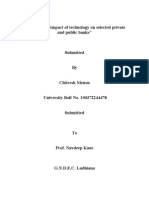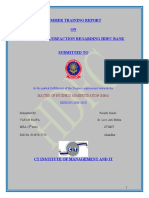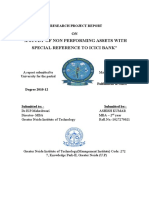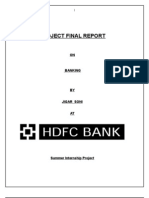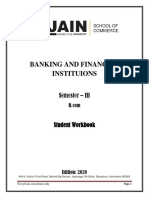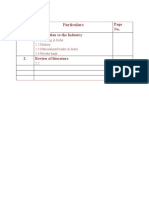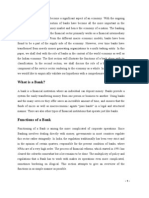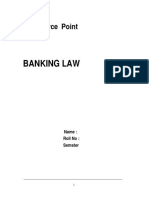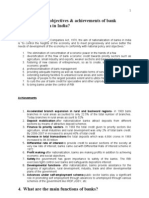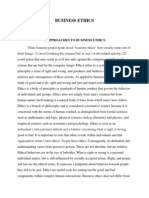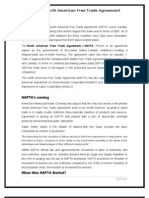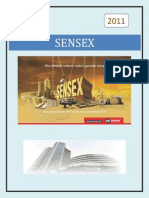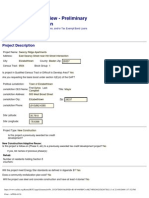Union Bank of India
Union Bank of India
Uploaded by
divyesh_variaCopyright:
Available Formats
Union Bank of India
Union Bank of India
Uploaded by
divyesh_variaOriginal Description:
Original Title
Copyright
Available Formats
Share this document
Did you find this document useful?
Is this content inappropriate?
Copyright:
Available Formats
Union Bank of India
Union Bank of India
Uploaded by
divyesh_variaCopyright:
Available Formats
Union Bank of India
CHAPTER 1
INDUSTRY INTRODUCTION
What is banking? The Banking Regulation Act 1949 defines banking as Accepting, for the purpose of lending or investment, of deposits of money from the public repayable on demand or otherwise and withdrawal by cheque draft, order or otherwise. In addition, banks also offer financial services, which include: Issuing demand draft & travelers cheque. Credit cards Collection of cheques, bill of exchange. Safe deposit lockers Custodian services. Investment and Insurance Services.
The business of banking is highly regulated since banks deal with money offered totem by the public and ensuring the safety of this public money is one of the prime responsibilities of any bank. Every bank has a compliance department, which is responsible to ensure that all the services offered by the bank, and the processes followed are in compliance with the local regulations and the Banks corporate police The major regulations and act governing the banking business are: Banking Regulation Act, 1949 Foreign Exchange Management Act, 1999 Indian Contract Act Negotiable Instruments Act, 1881
Bank lends money either for productive purposes to individual, firms, Corporate etc. of for buying house property, cars and other consumer durables and r investment purposes to individuals and the others. However, banks do mot finance any speculative activity. Lending is risk taking The Depositor of banks is also assured of safety of their money by deploying some percentage of deposit in statutory reserves like Statutory Liquidity & Ratio credit Rating Ratio.
Page | 1
Union Bank of India
BANKING INDUSTRY
Banking System Banking system is an integral sub-system of the financial system. It represent an important channel of collecting small saving from the households and ending it to the corporate sector. The Indian Banking system has the Reserve Bank of India (RBI) as the apex body for all matters relating to the banking system. It is the of Banks of In demand bankers to all others banks as well. Classification of Banks. 1. Non-Schedule Banks These are banks, which are not included in the second schedule of the Banking Regulations Act, 1965. It means they do not satisfy the conditions laid down by that schedule. They are further classified as back: Central co-operative banks and primary credit societies Commercial Banks
2. Schedule Banks Must have paid-up capital and reserve of mot less than Rs. 50, 00,000.The must satisfy the RBI than its affairs are mot conducted in a manner detrimental to the interests of its depositors. These are further classified as follow: State co-operative Banks Commercial Bank Private sector Public sector
Page | 2
Union Bank of India
CHAPTER 2
BANKING INTRODUCTION Meaning of Bank
It is generally said that the word BANK has been originated in Italy. In the middle of 12th century there was a great financial crisis in Italy due to war. To meet the war expenses, the government of that period imposed a forced subscribed loan on citizens of the country at the interest of 5% per annum. Such loans were known as Compare, Minute etc. The most common name was Monte. In Germany the word Monte was named as Bank or Bank. According to some writers, the word Bank has been derived from the word Bank. It is also said that the word Bank has been derived from the word Bunco which means a bench. The Jews money lenders in Italy used to transact their business sitting on benches at different market places. it is rightly argued that the word Bank has been originated from the World Bank. Today the word bank is used as a comprehensive term for a number institutions carrying on certain kinds of financial business. In practice, the work Bank means which borrows money from one class of people and again lends money to another class of people for interest or profit.
Definition of Bank
Bank is defined in many ways by various authors in the books on economics and commerce. It is very difficult to define a bank, because a bank performs multifarious functions. Different kinds of bank having different functions may be defined in different ways according to their functions. The evolution of different type of banks, each specialization in a particular field, gives emphasis on each and every kind of bank. A general and comprehensive definition to cover all types of banking institutions would be unscientific and probably impossible. Each type of bank should have its own definition explaining its specialized functions. Legislators have understood this difficulty and that is why the Bill of Exchange Act 1882 (England) defines thus A bank includes a body of persons, whether incorporated or not, who carry on the business of banking.
Page | 3
Union Bank of India
Importance of Banking
Bank plays a significant role in the economic development. The overall economic of a country is absolutely dependent on the efficient banking system. Industrial, agricultural and commercial progress of a country is not possible without a good banking system. The importance of banking may be stated as follows:
1. Capital Formation Economic development depends upon the division of economic resources from consumption to capital formation. Capital grows out of savings. Thus banks render a valuable service towards the development of a country by encouraging the growth of capital.
2. Development of Trade and Industry Bank utilizes their collected funds by advancing loans to commercial and industrial undertakings. In respect of foreign trade also, banks render a valuable service by issuing letter of credit etc.
3. Reservoirs of Funds Banks acts as the reservoirs of money in the country. In times of economic, crisis the bankers come forward to help the Government by purchasing the Government securities or by advancing loans.
4. Transfer of Funds Banks facilitate the transfer of funds from one place to another safely and at a very cheap cost through bank drafts, mail transfers, telegraphic transfer, travelers cherub etc.
5. Dealing in Foreign Exchange Banks deal in foreign exchange by purchasing and selling foreign currencies and by issuing letters of credit. Foreign remittances of funds are possible only through banks.
Page | 4
Union Bank of India 6. Money Market Operations The structure and ups and downs of money market in the country are largely dependent on the bankers activities. Under the guidance of the central bank all the banks in the country do their best for the sound management of money market.
7. Service to Customer Banks performs various agency services on behalf of their customers. They collect or make payments of bills of exchange, dividend, insurance premium etc, on behalf of their customers.
Functions of Modern Bank
The following is the list of functions or services rendered by a modern bank: 1. Bank provides inexpensive media of exchange through its cheques etc. 2. Bank keeps deposits of public. 3. Bank finances trade and industry. 4. Bank keeps in capital formation by economic savings. 5. Bank acts as Reservoir of funds. 6. Bank deals in foreign exchange and finances foreign trade. 7. Central Bank issues notes and controls money supply. 8. Central Bank controls credits, exchange and the money market. 9. All the banks participate in the development of money market. 10. Bank facilitates the transfer of funds from one place to another. 11. Specialized banks help in the development of agriculture and industry. 12. Banks acts as the custodian of customers valuables.
Page | 5
Union Bank of India 13. Bank acts as underwriters for raising capital or loan by Government, Public Bodies and Companies. 14. Bank acts as trustees and Executor of will and documents on behalf of their customers. 15. The Bank collects and makes payments of Bills of Exchange on behalf of its customers. 16. Bank advances loans and extend financial advices to its customers. 17. Bank Discounts Bills. 18. Bank purchases and sells stock exchange securities.
Qualities of Banking System
Every bank is a dealer in money and credit. It generally deals in with others money and not with its own money. It takes deposits from the public and again lends to its customers for the sake of interest or profit. Thus, the operation of banking business is very risky one. A bank must have some qualities in operating its functions efficiently and successfully. The qualities of good banking may be summarized as below 1. Adequate Capital A banker must have adequate amount of capital. A large scale operation and execution of various functions of a modern bank require large amount of capital at the initial stage. Thus, without sufficient capital no large scale banking can flourish.
2. Good Reputation Reputation is the most important factor in the progress of a bank. To be successful, a bank must have ample reputation in the money market. Reputation of a bank depends upon the qualifications of the directors and on the efficiency of management and workers.
Page | 6
Union Bank of India 3. Liquidity. Money which is dealt in by a bank is not its own, so a banker must always keep him ready to meet the claims of his depositors. He should keep sufficient amount of cash reserve and should keep some assets in such a way that these can be enchased at any moment. He should not block his fund by advancing loans for long periods rather he should always prefer short term credits.
4. Security and Safety In respect of advancing loans safety should be the main guiding principle for a bank. The loans advanced by the banker must be secured. The persons, to whom the advance is to be made, must be studied carefully before the lending of money. According to R.S. Sayers, The good banker is one who can distinguish the sound from the unsound borrower.
5. Economy Economy in expenditure should be maintained for the proper operation of banking business. A good banker will always try to maximize his profit at a minimum cost.
6. Effective Publicity A bank should adopt various scientific methods of advertisement for the proper publicity of business.
7. Localization Good locality of a bank is another quality. The bank should be located in the business centre so that it can flourish its business successfully.
8. Specialty To be successful, a bank should be specialized in any one or more fields of banking. An agricultural bank always aims at financing the formers for agricultural purposes. Industrial bank provides long terms credits to the industries. The individual commercial banks are also specialized in different fields of banking.
Page | 7
Union Bank of India 9. Good Show within the Office The bank office should be well equipped with modern amenities proper sitting arrangement should be made within the bank office for its customers.
10. Good Personnel and Efficiency The officers and the employees of the bank must be efficient in their work. They should be well trained in different fields of banking. Furthermore they should be well behaved and polite in the manner and must possess pleasing personality.
Classification of Banks
The banks can be classified on the following three bases: 1. Structural Classification of banking. 2. Operational Classification of banks. 3. Functional Classification of banks.
1. Structural Classification
Banks can be classified on the basis of their structure or constitution. According to structural classification, banking may be classified as (a) Branch Banking (b) Unit Banking.
a) Branch banking Under branch banking system, banking business is carried on through a network of branches in the same town or country under the guidance and control of one single head office. These branches may also be located in outside of the country. This system of banking was originated in the United Kingdom. Now-a-days this system if followed by many countries of the world including Pakistan.
b) Unit banking Under unit banking system the banking operations is carried through a single office without any branch. Remittances and foreign exchange etc are dealt through correspondence between banks of two places. The U.S.A is the home of unit banking.
Page | 8
Union Bank of India .
2. Operational Classification of Banks
On the basis of nature of operation, banks can be classified into the following two categories. A) Correspondent Banks The unit banks, having no branch are linked together by correspondent bank system. Under this system, a unit bank of a village or small town deposits a portion of its cash reserve with another bank in the nearest city. And this superior bank of city also deposits with another greater bank of big city. These unit banks are linked through correspondence. Remittances of funds of home and foreign trade transactions are made through these correspondent banks. The unit banks are completely independent of each other no doubt, but these are connected with one another through correspondent system.
B) Specialized Banks The bank which performs one or more special functions is known as specialized bank. As for example an agricultural bank takes up the special responsibility of financing agricultural activities. Industrial banks specially finance the industrial undertakings. Japan is the home of specialized banks where different types of specialized banks are working with their special functions. The specialized banks have a great role in the economic development of a country, especially of a developing country like Pakistan. In our country, Agricultural Development Bank of Pakistan is helping financially in the development of agricultural sector of our economy. The Industrial Development Bank of Pakistan is another specialized bank who is financing large scale industries in Pakistan.
3. Functional Classification of Banks
Banks may be classified according to their functions. Different kinds of banks, with different functions may be summarized as follows: a) Central Bank A central bank is the most important institution in the banking system of a country established with the objective of regulating the banking and monetary system of the country. It issues notes and currencies within the country and is entrusted with responsibility of maintaining the price
Page | 9
Union Bank of India level in the country stable. It acts as banker to the Government and it directly or indirectly controls the activities of all other banks. State Bank of Pakistan is Central Bank of our country.
b) Commercial Bank Such type of bank is cheerfully engaged in financing internal trade. It deals in short term credit. It takes deposit from public through different type of deposit accounts and invests that collected fund in advances and loan of short period to the trading and commercial undertaking. This type of bank is familiar in most of the world. In our country, for example, National Bank of Pakistan, Habit Bank Limited, United Bank Limited, Muslim Commercial Bank Limited and Allied Bank Limited are the commercial banks.
c) Industrial Bank Such institution specializes in financing industry. It provides long term credit to people who carry on industrial enterprises. Industrial Development Bank of Pakistan (IDBP) and Pakistan Industrial Credit and Investment Corporation (PICIC) are the examples of industrial banks.
d) Agricultural Bank Such bank provides long and short term finance to agriculturists for their agricultural purposes. Long term capital is required for acquisition and improvement of land and purchase of heavy machinery and equipments. Short period capital is required by the farmers for current expenditure on seed, manures, wages etc. Agricultural Development Bank of Pakistan (ADBP) is the best example of agricultural bank in our country that provides long term, medium term and short term loans to the agriculturists.
e) Exchange Bank Exchange bank deals mainly in the finance of the foreign trade of the country. It deals in foreign exchange. On other wards, the main function of such bank is to buy and sell foreign currencies, rather titles to foreign currencies in the form of bills of exchange, drafts, telegraphic transfers etc. It purchases the bill of exchange which arises in connection with the import and export trade of the country and they deal in exchange.
Page | 10
Union Bank of India f) Cooperative Bank This type of bank is organized mutually by the persons of similar occupations within the objectives of providing banking and credit facilities to the members. Generally in every country. Government patronizes co-operative banks in order to encourage the cultivators, fisherman, workers in the factories etc.
g) Mortgage Bank Mortgage bank advances long term credits against securities of immovable properties like, agricultural lands, buildings and machineries etc. Generally, credit is give to the agriculturist, small industries or house builders. This type of bank is essential in an under developed country where capital supply is very limited. In our country, House Building Finance Corporation is functioning as mortgage bank providing long term loans to house builders against securities of building and land property.
h) Savings Bank Such banks provide facilities to people to save money. This type of bank is established with the objective of promoting the thrift or saving habits among the people of small incomes. It takes deposits from the public and lands the collected funds to traders Depositors are allowed to withdraw money from their deposits twice in a week. Post offices in Pakistan carry on functions of saving bank.
Page | 11
Union Bank of India
Chapter 3 Union bank of India
Introduction
Union Bank of India (UNION BANK OF INDIA) is one of India's largest state-owned banks (the government owns 55.43% of its share capital), is listed on the Forbes 2000. It has assets of USD 13.45 billion and all the bank's branches have been networked with its 1135 ATMs. Its online Telebanking facility is available to all its Core Banking Customers - individual as well as corporate. It has representative offices in Abu Dhabi, United Arab Emirates, and Shanghai, Peoples Republic of China, and a branch in Hong Kong The Union Bank of India was built up in twentieth century and declared open by the Father of the Nation, Mahatma Gandhi. The bank with its efficient value-added services, sustained growth, consistent profitability and development of new technologies bank has ensured complete customer delight, living up to its image of, GOOD PEOPLE TO BANK WITH. Bank is offering credit cards, home loan, union demit, Kisan ATM, International debit card, online tax payment facility, Railway e-ticketing kiosk, etc., services to its customers through core banking solution. The Union Bank of India has 2261 branches out which 1031 branches are under CBS. All the ATMs are inter-connected through the Banks ATM Switch, thus facilitating on-line operations in case of CBS customers. The Bank is a member of Cash Tree consortium and also has bilateral arrangement with State Bank of India, enabling the Banks ATM cardholder access to over 20000 ATMs across the country. UNION BANK OF INDIA Net connects 65 Offices and 984 branches located in 323 centers, facilitating speedier transmission of MIS data (Network Map). The network also facilitates the implementation of Core Banking Solution, apart from DEMAT services, Cash Management services, fund transfers, messaging system, etc. The Bank is using VSAT network for connecting branches and ATMs wherever leased line connectivity is not feasible. We have 590 VSATs operational, connecting 194 branches/extension counters and 316 ATMs
Page | 12
Union Bank of India
HISTORY
Union Bank of India (UBI) was registered on 11 November 1919 as a limited company in Mumbai and was inaugurated by Mahatma Gandhi. At the time of India's Independence in 1947, UNION BANK OF INDIA still only had four branches - three in Mumbai and one in Saurashtra , all concentrated in key trade centers. After Independence UNION BANK OF INDIA accelerated its growth and by the time the government nationalized it in 1969, it had grown to 240 branches in 28 states. Shortly after nationalization, UNION BANK OF INDIA merged in Belgaum Bank, a private sector bank established in 1930 that had it merged in a bank in 1964, the Sheri Judea Shankar ling Bank. Then in 1985 UNION BANK OF INDIA merged in Mira State Bank, which had been established in 1929. In 1999 the Reserve Bank of India requested that UNION BANK OF INDIA acquire Sikkim Bank in a rescue after extensive irregularities had been discovered at the non-scheduled bank. Sikkim Bank had eight branches located in the North-east, which was attractive to UNION BANK OF INDIA. UNION BANK OF INDIA began its international expansion in 2007 with the opening of representative offices in Abu Dhabi, United Arab Emirates, and Shanghai, Peoples Republic of China. The next year, UNION BANK OF INDIA established a branch in Hong Kong, its first branch outside India. In 2009, UNION BANK OF INDIA opened a representative office in Sydney, Australia.
Page | 13
Union Bank of India
VISION & MISSION VISION
To be the premier financial institution in the emerging markets Technologically Strong Financially Sound All India presence Personalized Services Value Maximization Employee Satisfaction Skill Maximization
MISSION
To Be Premiere Bank, Responsive To The Needs Of Our Target Market Customers, Recognized For Consistently Superior Service Quality Innovative Products, Thereby Delivering Superior Value To Our Shareholders
Page | 14
Union Bank of India
Objective of the study
The objective of the study was to know the financial performance (i.e. the profitability and financial position) of Union Bank of India for the financial year 2009-2010. Some other objectives were as follows:
To study the evaluation and performance of the bank To study the financial statement To study the source of financial of the bank
Scope of the study
Each and every project study along with its certain objectives also has scope for future. And this scope in future gives to new researches a new need to research anew project with a new scope. Scope of the study not only consist one or two future business plan but sometime it also gives idea about a new business which becomes much more profitable for the researches then the older one. Scope of the study could give the projected scenario for a new successful strategy wit Ha proper implementation plan. Whatever scope I observed in my project are not exactly having all the features of the scope which I described above but also not lacking all the features: Research study could give an idea of network expansion for capturing more market and customer with better services and lower cost, without compromising with quality. In future customer requirements could be added with the product and services for getting an edge over competitors Different parameter could also be used for the purpose of launching a new product with extra benefits which are required by customers. Factors which are responsible for the performance for bank can also be used for the modification of the strategy and product for being more profitable. These all could also be interchanged with each other for each other in banks strategies for making a final business plan to affect the market with a positive way without disturbing a lot to market, customers and competitors with disturbance in market shares.
Page | 15
Union Bank of India
PRODUCTS AND SERVICES
UNION BANK OF INDIA provides various types of product and services .The wide range of product and services consists of
BANKING
Accounts & Deposits cumulative deposit scheme, deposit reinvestment certificate, monthly income scheme, union flexi-deposit, senior citizens scheme, multi gain savings account, no frills saving account, union super salary account, union classic current account Retail Loans union cash, union home, union health, union miles, union education, and union top up, EMI calculator, union smile. Cards -Classic /Silver / Gold, Corporate Credit Cards, Add-On Cards Insurance & Investment mutual fund, union healthcare Demit demit accounts, online share trade Payment
NRI Banking
Remittance -Union E-Remit, Details for Remittance Savings & Deposits - NRO Non Resident Ordinary A/c Scheme, NRE Non Resident External Rupee, R FC,FCNR(B),Union Unfixed ,Foreign Currency Deposit
Loan &Services house loans, foreign currency loans, loans against deposit, immovable property, and shares or debenture Payments -Union Bill Pay
Page | 16
Union Bank of India
Corporate Banking
CMS-Union Speed, Union Centralized Debits/Credits, Union Prompt E-Tax -Customs and Direct taxes, DGFT, Central Excise and Service Tax Trade Finance trade finance for exporters, trade finance for importers, foreign currency loans, correspondent banking Insurance - Non life Insurance Corporate Agency, Insurance-Corporate Agency Syndication of Loans MSME Banking Loans & Policies
Internet Banking
Account Information Transfer of Funds Bills Requests Mails Trade Limits Currency U pleads Customization Financial enquiries Non Financial enquiries
Page | 17
Union Bank of India
COMPANY PROFILE
Union Bank of India (UBI) is one of India's largest state-owned banks (the government owns 55.43% of its share capital), is listed on the Forbes 2000. It has assets of USD 13.45 billion and all the bank's branches have been networked with its 1135 ATMs. Its online Telebanking facility is available to all it score Banking Customers - individual as well as corporate. It has representative offices in Abu Dhabi, United Arab Emirates, and Shanghai, Peoples Republic of China, and a branch in Hong Kong
The Union Bank of India was built up in twentieth century and declared open by the Father of the Nation, Mahatma Gandhi. The bank with its efficient value-added services, sustained growth, consistent profitability and development of new technologies bank has ensured complete customer delight, living up to its image of, GOOD PEOPLETO BA NK WITH. Bank is offering credit adds, home loan, union demit, Kinas ATM, International debit card, online tax payment facility, airway eticketing kiosk, etc., services to its customers through core banking solution.
He Union Bank of India has 2261 branches out which1031 branches are under CBS. All the ATMs are inter-connected throug h the Banks ATM Switch, thus facilitating on-line operations in case of CBS customers. The Bank is a member of Cash Tree consortium and alohas bilateral arrangement with State Bank of India, enabling the Banks ATM cardholder access to over 20000 ATMs across the country. UNION BANK OF INDIA Net connects 65 Offices and 984 branches located in 323centers, facilitating speedier transmission of MIS data (Network Map).The network also facilitates the implementation of Core Banking Solution, apart from DEMAT services, Cash Management services, fund transfers, messaging system, etc. The Bank is using VSAT network for connecting branches and ATMs wherever leased line connectivity is not feasible. We have 590 VSATs operational, connecting 194 branches/extension counters and 316 ATMs.
Page | 18
Union Bank of India
Profile of Union Bank of India For Dun & Bradstreet
Union Bank of India was established on Nov 11, 1919 and is head quartered in Mumbai. The registered Office of the Bank was inaugurated by Mahatma Gandhi, father of the Nation in the year 1921. Along with 13 other banks, Union Bank of India was nationalized in the year 1969 in the first phase. Union Bank has the distinction of making profits consistently for the last 89 years since inception.
Business Operations
Union Bank has huge and varied customer base approximating to 24 millions. Bank is targeting customers from all demographic and economic profiles and introducing products and services to meet their needs. The Bank operates in all the areas including retail lending, personal banking, corporate banking, international banking and investments & treasur y. Banks lending also caters to the rural and semi urban centers, financing Agriculture and allied activities, rural artisans, micro & medium enterprises in these areas. Bank has opened 198 Village Knowledge Centers to provide information to the local community on better agriculture practices, commodities, marketing facilities and financial education. Bank also offers third party products like life and general insurance, mutual funds, on-line trading, wealth management services through tie- up with other FIs. Bank places customer at the centre of all its operations and has transformed the process, people and organizational structure. Bank has initiated a large scale transformation process named Nav Nirman to address two critical aspects of growth-instilling the drive of sales & marketing across bank staff and reconfiguration of banks business model. The transformation process focuses on four key initiatives a) Retail Asset (marketing & processing) b) SME marketing & processing) c) Branch sales and services (improving the customer experience in the branch) d) Centralization of key processes
Page | 19
Union Bank of India Bank has brought all its branches under Core banking solutions .Union Bank is the first large bank to achieve 100% CBS roll out. Bank has taken lead to establish alternate delivery channels in the form of ATMs, internet banking, phone banking and Mobile Banking. Bank has introduced many technology based services like RTGS, online NEFT free of cost, on line application for products and services and online redressed of grievances.
Network and distribution
The business is grouped under various Verticals and well defined Business Strategic Units were formed, which will drive the growth. Bank has a network of more than 2500 service outlets which includes specialized branches for MSME (SME SARALS), corporate credit, Union Loan points for Retail Products etc. Bank has representative offices in Abu Dhabi and Shanghai and is in the process of opening its office in Sydney, Australia. A fully fledged overseas branch was opened in Hong Kong. To serve the varied banking needs of the NRIs, Bank has placed number of Marketing Officials at various centers in UAE and Shanghai. Bank has plans to deploy more number of Marketing Officials at many other places. Bank plans to open 500 new branches in the next six months for which it has received licenses from RBI. The bank will accelerate its presence in the global market space at key locations in the next two years as part of the Vision strategy.
Diversification
Union Bank in partnership with Bank of India and Dai-Ichi of Japan has formed a subsidiary for distribution of Life insurance products, which has started selling the products. Bank has signed an agreement with Belgian KBC group for setting up a joint venture AMC in India. Union Bank has signed Mau with NSIC for training and setting up Incubation cum Training centers to promote first generation entrepreneurs in MSME segment. Bank has entered into Mou with NCMSL for financing against warehouse receipts for agri. commodities kept at NCMSL warehouses. Bank has announced opening 100 specialized Business Banking branches across the country to focus exclusively on MSME sector with turnaround time of 2 weeks for sanction of proposals. Bank has launched mobile banking facility U mobile which facilitates limited transactions and other services through mobile phones.
Page | 20
Union Bank of India
Growth & Performance
Total business of the Bank at the end of Dec08 stood at Rs.2,22,625 crore registering a growth of 28.33 % over Dec07.The banks total deposits as on 31st Dec08 reached a level of Rs.1,29,647 crore from Rs.99227 crore as on Dec07 ,an increase of 30.66%. Gross advances of the Bank reached a level of Rs.92,978 crore as on 31st Dec08,registering a growth of 25.22% over Dec07.The Capital Adequacy Ratio of the Bank (BASEL I) is at 12.32% & BASEL II at 13.41 % as on Dec08.The net interest margin of the Bank increased to 2.97% for the nine months period ended Dec08.Return on average assets improved from 1.31% in Dec07 to 1.92% in Dec08 indicating more efficient use of Funds. The asset quality recorded a significant improvement with steep reduction in Net NPAs from 0.35% in Dec07 to 0.14% in Dec08 and the Gross NPAs from 2.10% to 1.68%.
The brand and the promises
Bank has adopted a simple new logo for universal appeal and to aid top of mind recall. The new logo symbolizes the qualities and values we stand for- Blue standing for the commitment and the Red for the passion the Bank brings to the work. Union bank has promised 4 key deliverables to customers based on the strength built in 1) Value for money 2) Committed turnaround time for delivery of products and services 3) Choice of banking channels for customers and 4) Transparency in product offerings and prices
Bank promises that YOUR DREAMS ARE NOT YOUR ALONE ,there is a bank that is ready to fulfill the dreams of every one and thus ensuring that we remain GOOD PEOPLE TO BANK WITH for all times to come.
Page | 21
Union Bank of India Last 5 years balance sheet of union bank of India
Balance sheet - Union Bank of India Particulars Liabilities Share Capital Reserves & Surplus Net Worth Secured Loans Unsecured Loans TOTAL LIABILITIES Assets Gross Block (-) Acc. Depreciation Net Block Capital Work in Progress. Investments. Inventories Sundry Debtors Cash And Bank Loans And Advances Total Current Assets Current Liabilities Provisions Total Current Liabilities NET CURRENT ASSETS Misc. Expenses TOTAL (A+B+C+D+E) ASSETS 3,720.39 1,388.20 798.36 3.61 62,363.56 0.00 0.00 15,675.14 3,598.41 1,319.21 705.36 13.58 58,399.14 0.00 0.00 20,098.44 3,396.98 1,101.50 679.51 9.96 54,403.53 0.00 0.00 15,776.69 3,220.65 893.35 641.32 7.86 42,996.96 0.00 0.00 15,984.93 2,937.45 741.62 471.44 4.57 33,822.63 0.00 0.00 10,097.84 77,952.40 Mar'12 12 Months 661.55 12,437.68 14,633.06 17,909.49 Mar'11 12 Months 635.33 10,555.35 12,764.52 13,315.97 Mar'10 12 Months 505.12 8,302.69 10,423.78 9,215.31 Mar'09 12 Months 505.12 6,549.26 8,740.35 3,884.90 Mar'08 12 Months 505.12 5,118.19 7,347.70 4,760.49
222,868.95 202,461.29 170,039.74 138,702.83 103,858.64 255,411.49 228,541.78 189,678.83 151,328.08 115,966.84
181,836.94 155,194.08 122,676.18 99,658.46
197,512.08 175,292.53 138,452.88 115,643.39 88,050.24 6,799.95 0.00 6,799.95 7,442.67 0.00 7,442.67 5,483.01 0.00 5,483.01 9,647.43 0.00 9,647.43 8,106.43 0.00 8,106.43
190,712.14 167,849.86 132,969.86 105,995.96 79,943.80 0.00 0.00 0.00 0.00 0.00
255,411.49 228,541.78 189,678.83 151,328.08 115,966.84
Page | 22
Union Bank of India Last 5 years profit & loss a/c of union bank of India Profit & Loss - Union Bank of India Mar'12 Mar'11 Mar'10 Mar'09 Mar'08
12 Months 12 Months 12 Months 12 Months 12 Months INCOME: Sales Turnover Excise Duty NET SALES Other Income TOTAL INCOME EXPENDITURE: Manufacturing Expenses Material Consumed Personal Expenses Selling Expenses Administrative Expenses Expenses Capitalized Provisions Made TOTAL EXPENDITURE Operating Profit EBITDA Depreciation Other Write-offs EBIT Interest EBT Taxes Profit and Loss for the Year Non Recurring Items 0.00 0.00 2,479.83 67.40 2,804.57 0.00 975.24 6,327.03 2,796.71 3,835.10 146.45 0.00 3,688.65 14,235.39 2,713.42 925.62 1,787.80 -0.6 0.00 0.00 2,600.25 94.08 2,287.70 0.00 135.25 5,117.28 2,465.86 3,246.66 155.66 0.00 3,091.00 10,236.42 2,955.76 873.45 2,082.31 -0.3 0.00 0.00 1,354.99 38.98 1,652.65 0.00 244.81 3,291.43 2,510.35 3,238.51 160.14 0.00 3,078.37 9,110.27 2,833.56 758.00 2,075.56 -0.6 0.00 0.00 1,152.36 132.63 1,339.02 0.00 217.97 2,841.98 2,201.88 10,777.68 136.58 0.00 10,641.10 8,075.81 2,347.31 630.00 1,717.31 9.24 0.00 0.00 845.68 34.49 1,196.21 0.00 90.94 2,167.32 1,686.24 8,428.18 101.82 0.00 8,326.36 6,360.95 1,874.47 487.15 1,387.32 -0.2 22,383.89 0.00 22,383.89 0.00 23,422.28 17,684.30 0.00 17,684.30 0.00 18,465.11 14,667.24 0.00 14,667.24 0.00 15,395.40 12,901.70 0.00 12,901.70 0.00 13,401.69 10,123.58 0.00 10,123.58 0.00 10,504.56
Page | 23
Union Bank of India Other Non Cash Adjustments Other Adjustments REPORTED PAT KEY ITEMS Preference Dividend Equity Dividend Equity Dividend (%) Shares in Issue (Lakh) EPS - Annualized (Rs) 10.54 440.44 80.00 5,505.49 32.46 5.16 419.47 79.99 5,243.32 39.71 0.00 277.81 55.00 5,051.18 41.08 0.00 252.56 49.99 5,051.18 34.18 0.00 202.05 40.00 5,051.18 27.46 0.78 -0.7 1,787.14 0.00 0.00 2,081.95 0.00 0.00 2,074.92 0.00 0.00 1,726.55 0.00 0.00 1,387.03
FINANCIAL PERFORMANCE HIGHLIGHT of 20010-2010
Total Business size of Rs. 2, 91,289 crore as on March31, 2010 an increase of 22.9% over previous year. Total Deposits of Rs. 1, 70,040 crore, an increase of 22.6%.CASA deposits grew at 29.4%, its share increased by 166 basis points to 31.73%. Total Advances of Rs. 1, 21,249 crore, an increase of 23.4%. Retail advances grew at 33.8% Net Profits of Rs. 2,075 crore, an increase of 20.2% over the previous year. Core Fee Income of Rs. 896 crore, an increase of 32.74% over the previous year. Capital Adequacy Ratio (Basel IICAR) stood at12.51%as on March31, 2010 as against regulatory minimum of 9.0%.Tier I ratio at 7.91%. Return on average assets1.25% Return on equity recorded at23.69%. Book Value per share of Rs. 173.38, an increase of 25.6% over the previous year. Earnings per share increased to Rs. 41.08, compared to Rs. 34.18 of previous year. Cost to Income ratio of 40.66%, reduced by 115 basis points over the previous year. Proposed Dividend up from 50% to55%. Pan India reach- Network of 2,805 branchesand2327 ATMs as on March 31, 2010. Global Expansion: Opened representative offices in Sydney (Australia) and Beijing (China).Representative office in London opened on April 1, 2010.
Page | 24
Union Bank of India
1.
As on March31, 2010, Total Business of the bank stood at Rs. 2.91 lakh crore as against Rs. 2.37 lakh crore as on March31, 2009, an increase of 22.9%.The business growth was broad-based with contribution from retail and corporate customers, both on assets and liabilities side.
2.
The Bank posted a total income and net profit of Rs. 15,277 crore and Rs. 2,075crore respectively for the financial year ended March31, 2010 as against Rs.13372 crore and Rs. 1727 crore respectively in the previous year. The Earning per share (EPS) ratio showed improvement to Rs. 1.08 as against Rs. 34.18 in the previous year, while cost to income ratio declined to 40.66% as against 41.81% in the previous year.
Page | 25
Union Bank of India
Page | 26
Union Bank of India
Page | 27
Union Bank of India
Page | 28
Union Bank of India
Total Capital Adequacy ratio (CAR), calculated in line with Basel II framework, and stood at12.51%, well above the regulatory bench mark of 9%. Bank s Tier-ICAR was 7.91%
Page | 29
Union Bank of India
The operating expenses stood at Rs. 2508 crore compared to Rs. 2214 crore, relatively a lower growth of 13.28% compared to 38.98% growth in previous year. The operating profit of the Bank registered a growth of 18.72% to Rs. 3659 crore from Rs.3082 crore in the previous year. Profit after tax net profit increased to Rs. 2075 crore compared to Rs. 1727 crore achieved ruing last year. Buoyancy in the core business operations supported by healthy growth in Non-Interest Income helped Bank achieves a 20.15% growth in net profit. Bank s operating profit and net profit
Page | 30
Union Bank of India CAGR during the financial year 2006- 07 to2009-10 is at 22.3% and 34.9% respectively Net-worth improved by 25.76% to Rs. 8758 crore from Rs. 6964 crore as reported during last year. The book value per share increased to Rs. 173.38 from Rs. 137.87.The return on equity stood at 23.69% and earnings per share increased to Rs. 41.08 from Rs. 34.18 reported during last year. The earnings per share grew at CAGR of 34.9% duringFY07 toFY10.
FINDINGS
Total Capital Adequacy ratio (CAR), stood at 12.51%, well above the regulatory benchmark of 9%.
Profit after tax net profit increased to Rs. 2075 crore compared to Rs. 1727crore achieved during last year.
The operating expenses registered a lower growth of 13.28% compared to38.98% growth in previous year. The operating profit of the Bank registered growth of 18.72%.y Net-worth improved by 25.76%.
The return on equity stood at 23.69% and earnings per share increased to Rs.41.08 from Rs. 34.18. .Cost to Income ratio has decreased by 115bps to 40.66% as compared to41.81% reported during last year.
The return on average assets is maintained at a healthy rate of 1.25% as onMarch31, 2010
Page | 31
Union Bank of India
Chapter 4
Objective of the Study
The objective of the current project is to conduct a diagnostic study of the Coimbatore cluster with a view to develop a one-point reference document which will provide a platform to highlight the operational aspects of prominent industries present in the cluster, which include engineering and textiles.
Methodology
1. Desk Research; - A detailed review of relevant literature for the Coimbatore cluster was conducted at this stage. This was complemented by a literature review of the prominent industries in the cluster. 2. Questionnaire Development; - In-depth desk research was conducted to construct a detailed questionnaire for survey focusing on the respective sectors. A survey of MSMEs through the means of a structured interview was conducted for fulfilling the objective. 3. Survey; - The survey was conducted on companies from each sector, operating in the cluster; which were randomly selected. The survey was done by a market research agency. Companies fulfilling the criteria of having annual turnover below ` 1,000 mn for FY10 and engaged in manufacturing activities were selected for the study. 4. Collection of Information; - All data and information gathered through surveys, information available in public domain, data gathered from firms, etc. was collated for the study. 5. Analysis of data and information; - All information was scrutinized and analyzed to explore the dynamics of the cluster.
Page | 32
Union Bank of India 6. Report Writing; - The outcome of the project including the analysis, results and key findings were written in the form of the current report. 7. Survey; - The survey was conducted on companies from each sector, operating in the cluster; which were randomly selected. The survey was done by a market research agency.
Key Areas of Operations
The business operations of UNION BANK OF INDIA can be broadly classified into the key income generating areas such as Retail Banking, International Banking, Agri-Banking and Treasury operations. The functioning of some of the key divisions is Key Business Areas of the Bank UNION BANK OF INDIA
Retail Banking International Banking
Corporate Banking
Treasury
a) Retail Banking
Retail banking segment is growing rapidly in the Indian banking industry. Every bank wants to grow in this particular segment because of the higher margins. UNION BANK OF INDIA is also showing a strong growth in this business segment. The retail banking business provides financial products and services to its retail customers. The bank provide housing, retail trade, automobile, consumer, education and other personal loans and deposit services, such as demand, savings and fixed deposits, for our customers. In addition, UNION BANK OF INDIA distribute products such as global debit cards and global credit cards. The bank also provides utility services such as bill payment. The bank also distributes third-party products, including mutual fund products and
Page | 33
Union Bank of India general and life insurance policies. Development of efficient ways of reaching to the customers and processing transactions is a key element of the banks goal to expand its profitability and to capitalize on opportunities for organic growth. The bank has sought to strengthen the information technology through development of its core banking services and other initiatives. UNION BANK OF INDIA has made progress towards networking, computerizing and interconnecting its branches, ATMs and other delivery channels. As at September 30, 2006, more than 80% of its business was through computerized network. In addition, the bank has introduced Internet banking for customers at its computerized branches.
b) International Banking
The bank had a robust growth in International Banking Business. The foreign exchange turnover, which was Rs361.02bn in 2004-05, reached the level of Rs408.94bn during the year, registering a growth of 13.27%.The bank is having a correspondent relationship with 345 leading international banks at all major international centers. The bank has entered into Rupee Drawing Arrangements (RDA) with 23 international banks and 13 exchange houses in the Middle East. The bank has also introduced Internet-based On-line Remittance Product for Non-Resident Indians (NRIs) in U.K. and U.S.A as well as for exchange houses in the Middle East. The bank is one of the leading players in the bullion market and offers various financial products related to bullion at 10 centers in the country.
c) Corporate Banking
The Corporate Banking Segment of the bank offers various loan and fee-based products and services to large corporate, Small and Medium Enterprises (SMEs) and to the agriculture sector. In order to give a boost to the SME segment and to agriculture lending, the bank set up SME cells and adopted cluster-centric approach for agriculture lending in areas with rich potential for such activity. The bank also experimented with new delivery models for credit, including setting up low cost rural ATMs. The bank also focused on micro-finance business as a convenient distribution channel for its rural as well as low income customers.
Page | 34
Union Bank of India
d) Treasury
Besides the traditional role of liquidity management and maintenance of statutory requirements like Statutory Liquidity Ratio (SLR) and Cash Reserve Ratio (CRR), treasury operations focused on judicious investments, derivative transactions for hedging customers financial exposures as well as its own balance sheet exposures. Bullion trading also played an important role in treasury operations and products like metal loans and gold forwards were popularized. The bank has a well laid down treasury policy and risk management systems for undertaking such transactions
Page | 35
Union Bank of India
Chapter 5
CUSTOMERS SATISFACTION
Customer satisfaction refers to the extent to which customers are happy with the products and services provided by a business. Customer satisfaction levels can be measured using survey techniques and questionnaires
DEFINITIONS:
1) Customer satisfaction is equivalent to making sure that product and service performance meets customer expectations.
2) Customer satisfaction is the perception of the customer that the outcome of a business transaction is equal to or greater than his/her expectation.
3) Customer satisfaction occurs when acquisition of products and/or services provides a minimum negative departure from expectations when compared with other acquisitions Gaining
high levels of customer satisfaction is very important to a business because satisfaction customers
are most likely to be loyal and to make report orders and to use a wide range of Services offered by a business
There are many factors which lead in high levels of customer satisfaction including. Products and services which is customer focused and hence provide high levels of value for money. What is clear about customer satisfaction is that customers are most likely to appreciate the goods and services that they buy if they are made to feel special. This occurs when they feel that the products and services that they buy have been specially produced for them or for people like them.
Page | 36
Union Bank of India
BENEFITS OF CUSTOMER SATISFACTION
The importance of customer satisfaction and support is increasingly becoming a vital business issue as organization realize the benefits of Customer Relationship Management for providing effective customer service. Professionals working within customer-focused business or those running call centers or help desks, need to keep informed about the latest customer satisfaction techniques for running a valuable customer service function. From small customer service departments to large call centers, the importance of developing a valued relationship with customers using CRM is essential to support customer and long-term business growth.
What Do Customers Want?
Before we begin to create tools to measure the level of satisfaction, it is important to develop a clear understanding of what exactly the customer wants. We need to know what our customers expect from the products and services we provide. Customer expectations have two types 1) Expressed 2) Implied
Expressed:Customer Expectations are those requirements that are written down n the contract and agreed upon by both parties for example, product specifications and delivery requirements .Suppliers performance against these requirements is most of the items directly measurable.
Implied:Customer Expectations are not written or spoken but are the ones the customer would expect the supplier to meet nevertheless. For example, a customer would expect the service representative who calls on him to be knowledgeable and competent to solve a problem on the spot. There are many reasons why customer expectations are likely to change overtime. Process improvements, advent of new technology, changes in customers priorities, improved quality of service provided by competitors are just a few examples. The customer is always right. Suppliers job is to provide the customer what he/she wants, when he/she wants it. Customer satisfaction is customers perception that a supplier has met or exceeded their expectations.
Page | 37
Union Bank of India
WHAT CONSTITUTES SATISFACTION?
We cannot create customer satisfaction just by meeting customers requirements fully because these have to be met in any case. However failing short is certain to create dissatisfaction Major Attributes of customer satisfaction in banking industry can be summarized as: Product quality Premium Outflow Return on Investment Services Responsiveness and ability to resolve complaints and reject reports. Overall communication, accessibility and attitude.
WHAT ARE THE TOOLS?
Customer expectations can be identified using various methods such as: Periodic contract reviews Market research Telephonic interviews Personal visits Warranty records Informal discussions Satisfaction surveys
Depending upon the customer base and available resources, we can choose a method that is most effective in measuring the customers perceptions. The purpose of the exercise is to identify priorities for improvements. We must develop a method or combination of methods that helps to continually improve service.
Page | 38
Union Bank of India
CUSTOMER SATISFACTION SURVEYS
Formal survey has emerged as by far the best method of periodically the customer satisfaction. The surveys are not marketing tools but an information gaining tool. Enough homework needs to be before embarking on the actual survey. This includes: Defining Objectives of the Survey Design Survey approach Develop questionnaires and forms Administer Survey (Email, Telephone or Post) Method of compiling data and analyzing the findings Format of the report to present the findings
There is no point in asking irrelevant questions on a customer satisfaction questionnaire. The basic purpose is to find out what we are doing right or wrong. Where is the scope for improvement, where do we stand vis--vis other suppliers. How we can serve the customer better? A customer satisfaction measurement survey should at least identify the following objectives: Importance to customers (Customers priorities) Customers perception of suppliers performance Your performance relative to customers priorities. Priorities for improvement
Survey forms should be easy to fill out with minimum amount of time and efforts on customers part. They should be designed to actively encourage the customer to complete the questions. Yet they must provide accurate data should also be sufficiently reliable for management decision making. This can be achieved by incorporating objective type questions where customer has to rate on scale of say 1 to 10. For repeated surveys, you could provide the rating that was previously accorded by the customer. This works like a reference point for the customer. Space should always be provided for the customers own opinions this enables them to state any additional requirements or report any shortcomings that are not covered by the objective questions.
Page | 39
Union Bank of India Normally, we deal various personnel at various levels in the customers organization the buyer, user, receiving inspector, finance and purchase person etc. surveying a number of respondents for each customer gives a complete perspective of customer satisfaction. It may be necessary to device a different questionnaire for each of them. Respondents must be provided a way to express the importance they attach to various survey parameters. Respondents should be asked to give a weighting factor, again on a rating scale of say, 1 to 10, for each requirement. This gives a better indication of relative importance of each parameter towards overall customer satisfaction and makes it easier for suppliers to prioritize their action plans by comparing the performance rating (scores) with importance rating (weighing). `
CONSUMER RESEARCH IN DIFFERENT DISCIPLINES
A considerable body of literature exists on consumption, consumer behavior and consumer decision making process. Most of the consumer research focused on adopter categories, habits, attitudes and intentions rather than on actually measuring the satisfaction level with the service.
CONSUMER SATISFACTION PROCESS
The paramount goal of marketing is to understand the customer and to influence buying behavior. The process can be depicted as follows: Need recognition- realization of the difference between the desired and the current situation that serves as a trigger for entire process. Search for information. Pre purchase alternative evaluation. Consumption (utilization of the procured option) Post purchase alternative re-evaluation. Divestment (disposal of the unconsumed product and its remnants)
Page | 40
Union Bank of India
WAYS FOR MAINTAINING RELATIONS WITH THE CUSTOMERS ADOPTED BY UNION BANK OF INDIA
The ability of the banking industry to achieve the socio-economic objectives and in the process bringing more and more customers into its fold will ultimately depend on the satisfaction of the customers. We have a strong belief that a satisfied customer is the foremost factor in developing our business. A need was felt by us at Union bank of India that in order to become more customers friendly the Bank should come out with Charter of its services for the customers. Citizens 'Charter concept was considered as a base instrument to fill this need and accordingly this document was prepared. These documents were made in consultation with the users and high light sour Bank's commitments towards the customer satisfaction, thus ensuring accountability and responsibility amongst its officials and staff. This Code for customers not only explains our commitment and responsibilities along with the redressed methods but also specifies the obligation on the part of customers for healthy practices in Customer-Banker relationships. This is not a legal document creating rights and obligations. The Code has been prepared to promote fair banking practices and to give information in respect of various activities relating to customer service we wish to acknowledge the initiative taken by the Ministry of Finance, Government of India and Ministry of Administrative Reforms and Public Grievances for encouraging us to bring out this Code. We maintain constant consultations with our clientele through various Seminars,
Customer Meets, etc. to evaluate improve and widen the range of service to customer. However, all our customers are requested to keep us informed of their experiences about the various services rendered by the Bank and feel free to comment on this Code. We intend to bring it out in many Regional Languages in subsequent years.
Page | 41
Union Bank of India
COMMON PRACTICES FOLLOWED BY UNION BANK OF INDIA BRANCHES
Display business hours. Render courteous services. Attend to all customers present in the banking hall at the close of business hours. Provide separate 'Enquiry' or 'May I help you' counter at large branches. Offer nomination facility to all deposit accounts (i.e. account opened in individual capacity) and all safe deposit locker hirers (i.e. individual hirers).Display interest rates for various deposit schemes from time to time. Notify change in interest rates on advances. Provide details of various deposit schemes/services of the Bank. Issue Demand Drafts, Pay Orders, etc .Display Time-Norms for various banking transactions. Pay interest for delayed credit of out station cheques, as advised by Reserve Bank of India (RBI) from time to time. Accord immediate credit in respect of outstation and local cheques up to a specified limit Subject to certain conditions, as advised by RBI from time to time. Provide complaint/suggestion box in the branch premises.
Page | 42
Union Bank of India
CHAPTER 6
SURVEY REPORT
DATA ANALYSIS & INTERPRETATION
To know customer view about union bank of India, I have done survey of 20 peoples and ask them certain set of question: 1. When survey respondent were asked, do you have an account in this bank?
BANK ACCOUNT
100 90 80 70 60 50 40 30 20 10 0 YES NO 5% 95%
INTERPRETATION This bar diagram shows how many people are having bank account. 95% of the people are having bank account where as 5% of the people dont have an bank account
Page | 43
Union Bank of India 2. When survey respondent were asked, which type of account do you have?
TYPES OF BANK ACCOUNT
fixed A/c 26%
recurring A/c 5% current A/c 11%
saving A/c 58%
INTERPRETATION This pie diagram show which all bank account people are having. 55% people are having saving account. 10% people are having current account. 5% people are having recurring account. 25% people are having fixed account.
Page | 44
Union Bank of India 3. When survey respondent were asked, what is the purpose of opening an account in this bank?
45 40 35 30 security 25 20 45% 15 10 5 0 security interest good relation 35% 15% interest good relation
INTERPRETATION: This bar diagram show how people are known about bank account 45% people open an account for security 35% people open an account for interest 15% people open an account for good relation
Page | 45
Union Bank of India 4. When survey respondent were asked, how did you come to know about the facilities provided by this bank?
PUBLIC AWARENESS
45 40 35 30 25 20 15 10 5 0 10% 45% 30% 10% NEWS PAPER ADVERTISEMENT AGENT FRIEND
NTERPRETATION: This bar diagram shows how many people know about bank account. 10% people are aware about news paper. 30% peoples are aware about advertisement. 45% peoples are aware about agent. 10% peoples are aware about friend.
Page | 46
Union Bank of India 5. When survey respondent were asked, which types of features you like?
FEATURES
60 50 40 E-BANKING 30 55% 20 10 0 E-BANKING NEW SCHEMES ATM 20% 25% NEW SCHEMES ATM
INTERPRETATION: This bar diagram shows how many people like the features of this bank. 20% peoples like e-banking. 55% peoples like new schemes. 25% peoples like ATM.
Page | 47
Union Bank of India 6. When survey respondent were asked, do you think that the private sector is better than public sector?
WHICH IS BETTER
80 70 60 50 40 30 20 10 0 YES NO 20% 80% YES NO
INTERPRETATION: This bar diagram shows how many people says which is better. 80% people say that private sector is better. 20% people say that public sector is better.
Page | 48
Union Bank of India 7. When survey respondent were asked, which sector do you have prefer?
INTERPRETATION This bar diagram shows the people are prefer sector. 70 % of people are using public sector bank. 30 % of people are using private sector bank.
Page | 49
Union Bank of India 8. When survey respondent were asked, do you think the union bank is safe for your money?
SAFE FOR MANY
15%
YES NO
85%
INTERPRETATION This bar diagram shows how many people say that for safe of money 85% people are says that to safe the money. 15% people are says that not for safe of money.
Page | 50
Union Bank of India 9. When survey respondent were asked, youre level of satisfaction with union bank?
SATISFACTION
50 45 40 35 30 25 20 15 10 5 0 VERY SATISFIED NORMAL SATISFIED DISSATISFIED 30% 20% 50% VERY SATISFIED NORMAL SATISFIED DISSATISFIED
INTERPRETATION; This bar diagram shows the people are preferring sector: 30 % of people are very satisfied 50 % of people are normal satisfied 20 % of people are dissatisfied
Page | 51
Union Bank of India 10. When survey respondent were asked, If you have an option against union bank you will go for--
35 30 25 SBI 20 35% 15 20% 10 5 0 SBI AXIS ICICI OTHERS 25% 20% AXIS ICICI OTHERS
INTERPRETATION This bar diagram shows the how many people are go for other bank. 20 % of people go for state bank of India (SBI) 25 % of people go for AXIS bank 20 % of people go for ICICI bank 35% of people go for other bank
Page | 52
Union Bank of India
Chapter 7
LIMITATIONS: The time given for the summer internship i.e. 8 weeks was not sufficient enough to study and understand the retail loans approval process of the Union bank of India.
The banks have their own confidential information and it was very difficult to make the project and analyze it on the basis of hypothetical information
SUGGESTIONS: UNION BANK OF INDIA has this time ranked 5th among all the Nationalized banks. The reason for its ranking was the number of NPAs it had. It was found that a number of retail loans ended up in NPAs. UNION BANK OF INDIA needs to develop a competitive edge and the managers and the assistants need to keep a tab on the loans given.
Usually the managers would only fulfill their required target and then would forget about more borrowers. They need to have more borrowers both for small and big loans. Many times they pass a loan without the proper appraisal, i.e. the client may lack either the projected and estimated balance sheet or the proper documents. In such cases there should be a strict protocol followed
Page | 53
Union Bank of India
Chapter 8
CONCLUSION:As discussed in the project above, Credit Appraisal appears to be the back bone of the banking institution. It is equally important and dangerous, as there is always the chance of default or some other risk. After dealing with almost every aspect of loans and advances one can summarize that with a little bit of strict measures and a keen eye and understanding of a companys balance sheet one can very well save the institute the risk other than the default risk. Even the default risk can be to a certain limit mitigated, if we before sanctioning the amount check the profile of the customer. Industry Report, banks own experiences and the ability of the borrower to run his enterprise professionally are certain things one can check. A very crucial aspect of credit appraisal is the
Credit rating
Union bank has introduced their own Internal Rating system of all borrowers enjoying/seeking credit limits above Rs. 2 laces. The rating grades range from CR1 to CR8. Credit ratings up to CR5 are investment grade. CR6 toCR8 are non-investment grade as per the loan policy of the bank. Migration in credit rating
Especially downward migration should be discussed in detail and road map to improve the credit rating has to be drawn up/implemented. A lot of times for some reasons, credit report is not submitted and the submission of the proposal and its sanctioning is done without it, while keeping in mind other necessary factors. It is to be seen and made mandatory that the credit report must accompany the proposal as it gives a very clean and clear picture of the borrowers credit worthiness. In order to potential NPAs it is significant to have a fair understanding of the borrowers financial health. Thus, at least last three years balance sheet and Profit and loss accounts should be obtained, in addition to projections of next 2 years. Now, most of the time customers to prove their credit worthiness make the estimated balance sheets unrealistic, such areas should be stressed and it should be checked whether the borrower has the ability to go as per the projected Balance Sheet.
Page | 54
Union Bank of India The important factors which should be given special consideration are trend insoles, both quantity and quality, it should be positive with the industry trend. Disparities in the sales pattern should be analyzed properly. Profitability should be critically analyzed; it should be checked with the existing norms of the balance sheet. The distribution of profits and its impact at the reserve and surplus along with the tangible net worth should be seen. Increase/decrease in the term liabilities and its effect on capital employed should be scrutinized too. Increase or decrease in the investments of the borrower also needs to be looked at, it should be seen that the investments that the borrower is making should yield some income. The non current assets is another important aspect, it should be seen and commented upon. The debt equity ratio should be seen, if the debts are increasing and equity decreasing then such case should be discussed. Working Capital and its assessment should be done before taking a decision about the borrower. Credit rating is a very important step in deciding whether to sanction or decline a proposal. All the stages should be vetted and the necessary action should be taken while making any decision
Page | 55
Union Bank of India
Chapter 9
ANNEXURE
FORMATE OF CUTOMER SURVEY REPORT SURVEY ON PROJECT OF CUSTOMER SATISFACTION ON UNION BANK NAME:CONTACT NO.:1. Do you have an account in this bank? a. b. Yes. No.
2. Which type of account do you have? a. Saving Account. b. Current Account. c. Recurring account. d. Fixed Account 3. What is the purpose of opening an account in this bank? a. b. c. For Securities For Interest Good Relation
4. How did you come to know about the facilities provided by this bank? a. News Paper b. Advertisement c. d. Agent Friend
5. Which type of feature that you like? a. b. E-banking New Schemes
c. ATM
Page | 56
Union Bank of India 6. Do you think that the Private Sector is better than the Public Sector Bank? a. b. Yes. No.
7. Which sector do you have to prefer? a. Public Sector b. Private Sector
8. Do you think the UNION BANK is a safe for your money? a. b. Yes. No.
9.
Your level of satisfaction with UNION BANK? a. b. c. Very Satisfied Normal Satisfied Dissatisfied
10. If you will have an option against UNION BANK you will go fora. b. c. d. SBI AXIS ICICI OTHER
COMMENT:-_________________________________________________________PROJECT GUIDE: Mrs. Byshi Panikar CONDECTED BY: T.Y.B.COM (B & I) SURVEY
Page | 57
Union Bank of India
BIBLIOGRAPHY BOOKS 1. Financial Marketing, Author Name:- D.K. Bandgar, Edition:- Fifth, Semester:- Four (SYBBI) 2. International Banking And Finance, Author Name :- Deepak Abhyankar, Edition Sixth, Semester :- Fifth (TYBBI) WEB SIDE www.wikipedia.org/wiki/unionbank www.indianinfoline.com www.allbanksolution.com www.financialexpress.com/unionbank www.moneycontrol.com/unionbank/financialstatement www.timesofIndia/unionbank www.indiaeducation.net www.rbi.org.co.in
www.unionbank.com
NEWS PAPER Times of India Time of Economic
Page | 58
You might also like
- Electric Vehicle Loan CertificateDocument1 pageElectric Vehicle Loan Certificatejavedmonis0775% (16)
- Profit and Loss Statement Template V11Document24 pagesProfit and Loss Statement Template V11Rahul agarwal100% (4)
- Regional Rural Banks of India: Evolution, Performance and ManagementFrom EverandRegional Rural Banks of India: Evolution, Performance and ManagementNo ratings yet
- Icici Bank Project ReportDocument50 pagesIcici Bank Project ReportDilip Chudasama100% (1)
- Project On HDFC BankDocument72 pagesProject On HDFC Banksunit2658No ratings yet
- Comparative Study of Sbi Abd AxisDocument77 pagesComparative Study of Sbi Abd AxisNivesh GurungNo ratings yet
- HDFC BankDocument79 pagesHDFC BankAnkit YadavNo ratings yet
- A Study On Financial Performance of HDFC BankDocument53 pagesA Study On Financial Performance of HDFC BankFelix BadigerNo ratings yet
- A Project Report On HDFC and SbiDocument47 pagesA Project Report On HDFC and SbiMminu Charania100% (1)
- Financial Analysis of HDFC Bank: Project Report ONDocument103 pagesFinancial Analysis of HDFC Bank: Project Report ONAvonpreet KaurNo ratings yet
- Union Bank of IndiaDocument53 pagesUnion Bank of IndiaSonu DhangarNo ratings yet
- HDFC ProjectDocument93 pagesHDFC ProjectDevdutt Raina100% (1)
- Comparitive Analysis of Public Sector and Private Sectors Banks PDFDocument67 pagesComparitive Analysis of Public Sector and Private Sectors Banks PDFAnonymous y3E7ia100% (1)
- "Financial Analysis of HDFC Bank": Symbiosis Centre For Distance Learning, PuneDocument69 pages"Financial Analysis of HDFC Bank": Symbiosis Centre For Distance Learning, PuneBheeshm Singh100% (1)
- "Money Lending by Co-Operative Bank": A Project Report ONDocument78 pages"Money Lending by Co-Operative Bank": A Project Report ONvishalNo ratings yet
- Working Capital of Axis Bank"Document84 pagesWorking Capital of Axis Bank"Sami Zama100% (2)
- HDFC Bank Financial AnalysisDocument48 pagesHDFC Bank Financial AnalysisAbhinandan Bose50% (10)
- Axis Bank ProjectDocument78 pagesAxis Bank Projectzizz23No ratings yet
- A Study On Deposit Mobilization With Reference To Indian Overseas Bank, Velachery byDocument44 pagesA Study On Deposit Mobilization With Reference To Indian Overseas Bank, Velachery byvinoth_17588No ratings yet
- Customer Perception Towards The Products and Services of HDFC BankDocument54 pagesCustomer Perception Towards The Products and Services of HDFC BankShilpi GhoshNo ratings yet
- A Case Study Analysis On Non-Performing Assets at Union Bank of IndiaDocument56 pagesA Case Study Analysis On Non-Performing Assets at Union Bank of IndiaRahulKrishnanNo ratings yet
- Impact of Technology On Indian BanksDocument63 pagesImpact of Technology On Indian BanksAnoop Chahal0% (1)
- Comparative Study of The Public Sector Amp Private Sector BankDocument70 pagesComparative Study of The Public Sector Amp Private Sector BankSetuAgrawalNo ratings yet
- Final Project Report - Docx Axis BankDocument73 pagesFinal Project Report - Docx Axis BankSuraj GhongeNo ratings yet
- Sunil Project On Uco Bank FinanceDocument33 pagesSunil Project On Uco Bank FinanceSuksham Sood60% (5)
- Project Report On Ratio Analysis of HDFC BankDocument15 pagesProject Report On Ratio Analysis of HDFC BankRajat GuptaNo ratings yet
- Bank of Baroda ProjectDocument30 pagesBank of Baroda ProjectKevinRajNo ratings yet
- A Project On The Fund ManagementDocument12 pagesA Project On The Fund ManagementAswani B RajNo ratings yet
- Summer Training Project Report COPERATIVE BANKDocument53 pagesSummer Training Project Report COPERATIVE BANKkaushal24420% (1)
- Customer Satisfaction Regarding HDFC BankDocument104 pagesCustomer Satisfaction Regarding HDFC BankAmarkant0% (1)
- Canara BankDocument35 pagesCanara BankSambathkumar Madanagopal0% (1)
- Project On Bank of IndiaDocument57 pagesProject On Bank of IndiaShweta Yashwant Chalke0% (1)
- A Study of Non Performing Assets With Special Reference To Icici BankDocument92 pagesA Study of Non Performing Assets With Special Reference To Icici BankPrakash NikamNo ratings yet
- Project Report: "Study On Financial Services by Bank of Maharashtra ''Document60 pagesProject Report: "Study On Financial Services by Bank of Maharashtra ''Yash GandhewarNo ratings yet
- A Summer Project Report On Banking and SchemesDocument79 pagesA Summer Project Report On Banking and Schemessimran jeet67% (12)
- Project On Apex BankDocument32 pagesProject On Apex BankRishi Agarwal75% (4)
- IDBI BANK SHWETA GUPTApdf PDFDocument49 pagesIDBI BANK SHWETA GUPTApdf PDFshweta GuptaNo ratings yet
- Working Management of Axis BankDocument53 pagesWorking Management of Axis BankAayushi Sharma50% (2)
- Compare Govt and Private BankDocument68 pagesCompare Govt and Private BankRuman KhanNo ratings yet
- Consume Behavior BanksDocument109 pagesConsume Behavior BanksAnish NagpalNo ratings yet
- A Project Report On: "A Study On Banking Services in Bank of Baroda"Document63 pagesA Project Report On: "A Study On Banking Services in Bank of Baroda"pranoy100% (1)
- Apex Bank Project ReportDocument63 pagesApex Bank Project ReportPunith Kumar M67% (3)
- Punjab National BankDocument48 pagesPunjab National BankNaz Khilji75% (4)
- Personal Load in SbiDocument42 pagesPersonal Load in SbiNitinAgnihotriNo ratings yet
- Npa of SbiDocument40 pagesNpa of SbiLOCAL ADDA WAALENo ratings yet
- HDFC Bank Summer ReportDocument55 pagesHDFC Bank Summer Reportilover_140085% (20)
- Union Bank of IndiaDocument58 pagesUnion Bank of IndiaRakesh Prabhakar ShrivastavaNo ratings yet
- Union Bank of India PDFDocument58 pagesUnion Bank of India PDFashwin thakurNo ratings yet
- BII Final NOTES UNIT1Document26 pagesBII Final NOTES UNIT1SOHAIL makandarNo ratings yet
- Banking Financial InstitutionsDocument126 pagesBanking Financial InstitutionsMahalakshmi GowdaNo ratings yet
- JANKIDocument47 pagesJANKIJankiNo ratings yet
- Aditya Institute of Management Studies and Research: Banking & InsuranceDocument14 pagesAditya Institute of Management Studies and Research: Banking & InsuranceAnkita TrivediNo ratings yet
- Role of Commercial Banks in IndiaDocument6 pagesRole of Commercial Banks in Indiaakky.vns2004No ratings yet
- RitiDocument21 pagesRitiRiti NepaliaNo ratings yet
- Banking OmbudsmanDocument66 pagesBanking Ombudsmanmrchavan143No ratings yet
- Banking LawDocument149 pagesBanking LawJagriti SaikiaNo ratings yet
- Unit 2 Banking Innovations: Evolution of Banking in IndiaDocument8 pagesUnit 2 Banking Innovations: Evolution of Banking in IndiaAnitha RNo ratings yet
- Banking TheoryDocument299 pagesBanking TheoryMohammedNo ratings yet
- Accounts of IndividualsDocument67 pagesAccounts of IndividualsgauriNo ratings yet
- Meaning of Banking: 1. Central BanksDocument6 pagesMeaning of Banking: 1. Central BanksMuskanNo ratings yet
- 180 Sample-Chapter PDFDocument15 pages180 Sample-Chapter PDFhanumanthaiahgowdaNo ratings yet
- What Are The Objectives & Achievements of Bank Nationalization in India?Document32 pagesWhat Are The Objectives & Achievements of Bank Nationalization in India?rakesh4888No ratings yet
- Hindu Calendar Birth Month Baby Name Starting SyllableDocument2 pagesHindu Calendar Birth Month Baby Name Starting Syllabledivyesh_variaNo ratings yet
- Group No: V: Topic: Stress ManagementDocument14 pagesGroup No: V: Topic: Stress Managementdivyesh_variaNo ratings yet
- Business Ethics2Document19 pagesBusiness Ethics2divyesh_variaNo ratings yet
- North American Free Trade AgreementDocument30 pagesNorth American Free Trade Agreementpmithesh879100% (1)
- TCSDocument37 pagesTCSdivyesh_varia50% (2)
- Marginal Costing: A Management Technique For Profit Planning, Cost Control and Decision MakingDocument17 pagesMarginal Costing: A Management Technique For Profit Planning, Cost Control and Decision Makingdivyesh_variaNo ratings yet
- World BankDocument34 pagesWorld Bankdivyesh_variaNo ratings yet
- Kingfisher AirlinesDocument9 pagesKingfisher Airlinesdivyesh_variaNo ratings yet
- Role of Women in Indian PoliticsDocument5 pagesRole of Women in Indian Politicsdivyesh_variaNo ratings yet
- Management Information SystemsDocument20 pagesManagement Information SystemsashutoshkraoNo ratings yet
- Special Economic ZoneDocument44 pagesSpecial Economic Zonedivyesh_varia100% (1)
- Sen Sex2Document15 pagesSen Sex2divyesh_variaNo ratings yet
- Foreign Direct InvestmentDocument11 pagesForeign Direct Investmentdivyesh_variaNo ratings yet
- CARO 2010: Companies Audit Report Order 2003 - CARODocument5 pagesCARO 2010: Companies Audit Report Order 2003 - CAROdivyesh_variaNo ratings yet
- Ratio AnalysisDocument28 pagesRatio Analysisdivyesh_variaNo ratings yet
- Balance Sheet ExerciseDocument5 pagesBalance Sheet ExercisekatnissNo ratings yet
- 17 Hillsdale Ave, Burlington MA, 01803 - HomesDocument6 pages17 Hillsdale Ave, Burlington MA, 01803 - Homesashes_xNo ratings yet
- Articles of Partnership OF Helmdall, LTD.: Row, Ayala Center Mall, Cebu Business Park, 6000 Cebu CityDocument4 pagesArticles of Partnership OF Helmdall, LTD.: Row, Ayala Center Mall, Cebu Business Park, 6000 Cebu CityRose MarieNo ratings yet
- Treasury and Conservatorship by Timothy Howard Jan 11 2015Document8 pagesTreasury and Conservatorship by Timothy Howard Jan 11 2015dpsimswm100% (1)
- Swanzy RidgeDocument21 pagesSwanzy RidgeRyan SloanNo ratings yet
- Financial Distress (2008)Document24 pagesFinancial Distress (2008)Ira Putri100% (2)
- GS Paper (Author - Marish Valley Xaxa)Document90 pagesGS Paper (Author - Marish Valley Xaxa)Vineet SharmaNo ratings yet
- Credit Case Ditribution 1Document7 pagesCredit Case Ditribution 1Moachi SianenNo ratings yet
- Bit Digital (BTBT US)Document25 pagesBit Digital (BTBT US)ForkLogNo ratings yet
- CV Sigit Suryawan Recent 082Document6 pagesCV Sigit Suryawan Recent 082Del VidaNo ratings yet
- Housing Concept and Analysis of Housing Classification: Inita HenilaneDocument12 pagesHousing Concept and Analysis of Housing Classification: Inita HenilaneJaymie Rose ErodiasNo ratings yet
- Philippine Phoenix Surety & Insurance Company vs. Woodworks, Inc. G.R. No. L-25317 August 6, 1979Document12 pagesPhilippine Phoenix Surety & Insurance Company vs. Woodworks, Inc. G.R. No. L-25317 August 6, 1979Pat EspinozaNo ratings yet
- Unit Iv Fund Based Financial Services: Basic Concepts in LeasingDocument13 pagesUnit Iv Fund Based Financial Services: Basic Concepts in LeasingJessica TerryNo ratings yet
- Solution Chapter 9Document15 pagesSolution Chapter 9BobslaneLlenos0% (2)
- Arctic ExplorerDocument10 pagesArctic ExploreradventurecanadaNo ratings yet
- Invitation For Bid (Ifb) : Section - IDocument2 pagesInvitation For Bid (Ifb) : Section - IAnonymous 7ZYHilDNo ratings yet
- Financial Management Sample PoliciesDocument9 pagesFinancial Management Sample Policiessofyan timotyNo ratings yet
- HZLDocument57 pagesHZLricha_star13No ratings yet
- Hampton Machine Tool CompanyDocument5 pagesHampton Machine Tool Companydownloadsking100% (1)
- Dy, Jr. vs. Court of AppealsDocument8 pagesDy, Jr. vs. Court of AppealsMaria Nicole VaneeteeNo ratings yet
- FarDocument7 pagesFarVince MiramonNo ratings yet
- Accounts List DetailDocument1 pageAccounts List DetailRinaldiNo ratings yet
- Draft (Mahesha)Document25 pagesDraft (Mahesha)CcNo ratings yet
- IFA AssignmentDocument5 pagesIFA AssignmentAdnan JawedNo ratings yet
- Notice of DishonorDocument3 pagesNotice of DishonorbillNo ratings yet
- Contract of Indemnity and Guarantee (Article 3)Document12 pagesContract of Indemnity and Guarantee (Article 3)Mandira PrakashNo ratings yet
- Pastor D. Ago vs. Court of Appeals CASE DIGEST 2Document2 pagesPastor D. Ago vs. Court of Appeals CASE DIGEST 2Marion Lawrence Lara100% (3)
- CFPB Fair Credit Reporting Act Fcra ProceduresDocument86 pagesCFPB Fair Credit Reporting Act Fcra ProceduresJustin BurgessNo ratings yet





















